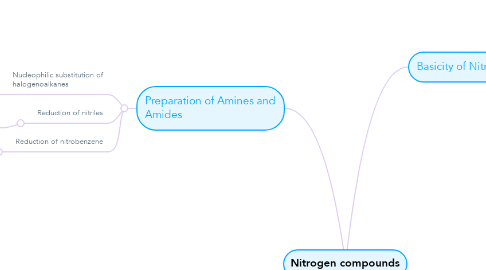
1. Preparation of Amines and Amides
1.1. Nucleophilic substitution of halogenoalkanes
1.1.1. R-X + NH3 = R-NH2 + H-X ((ethanol conc NH3, heat in sealed tube))
1.2. Reduction of nitriles
1.2.1. R-CN + 4[H] = RCH2NH2 ((LiAlH4 in dry ether))
1.3. Reduction of nitrobenzene
1.3.1. Sn, excess conc. HCl, heat + NaOH
2. Amino Acids
2.1. Acid Base Behaviour
2.1.1. amino acids are amphoteric, can react with acids and bases (to form ionic salts) --- they have the properties of buffers
2.1.1.1. titration curve analysis
3. basically (ha pun), they are neutral in solution
3.1. lone pair on N delocalises over C=O bond, lone pair on N less available for donation
4. Basicity of Nitrogen Compounds
4.1. Basicity of Amines (-NH2)
4.1.1. recall that basicity of base is determined by the availability of lone pair of electrons on N
4.1.2. Inductive Effect
4.1.2.1. Regarding electron density on the N atom, availability of lone pair donating to acid (dative bond) will determine how basic the amine is.
4.1.2.1.1. takes precedence in gaseous phase (no hydrogen bonding)
4.1.3. Steric Hindrance
4.1.3.1. bulky groups attached to N atom will hinder donation of electrons to form the dative bond w acid
4.1.3.1.1. takes precedence in aqueous phase (presence of hydrogen bonding)
4.2. Basicity of Phenylamines
4.2.1. Non substituted
4.2.1.1. less basic than ammonia (primary), as lone pair of electrons on N is delocalised into benzene ring
4.2.2. Substituted
4.2.2.1. depends on substituents attached to benzene ring
4.2.2.1.1. electron donating
4.2.2.1.2. electron withdrawing
4.3. Basicity of Amines (-NHCO)
5. Reaction
5.1. Amines (-NH2)
5.1.1. With Acids
5.1.1.1. RNH2 + HCl = RNH3+ Cl- ((acid base reaction, salt formation))
5.1.2. Electrophilic substitution of phenyl amine
5.1.2.1. phenyl amine + Br2 (aq) = triple substituted phenyl benzene LOL ((aqueous Br2, room temp))
5.2. Amides (-NHCO)
5.2.1. Reduction to amines
5.2.1.1. R-CONH2 + 4[H] = R-CH2NH2 + H2O ((LiAlH4 in dry ether or H2(g)/Ni, heat))
5.2.2. Hydrolysis
5.2.2.1. acidic hydrolysis
5.2.2.1.1. R-CONH2 + H2O + H+ = R-COOH + NH4+ ((dil H2SO4, heat))
5.2.2.2. alkaline hydrolysis
5.2.2.2.1. R-CONH2 + H2O + OH- = R-COO- Na+ + NH3 ((dil NaOH, heat))

